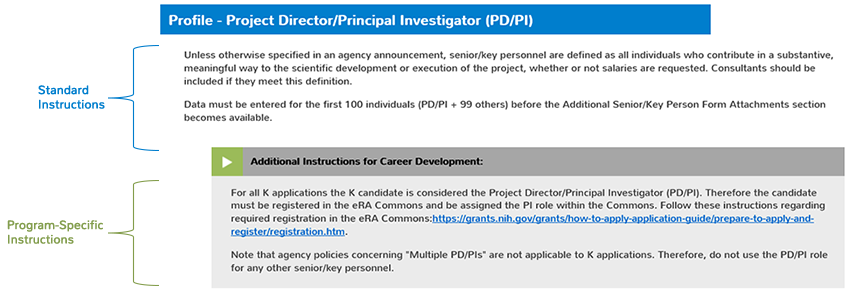G.100 - How to Use the Application Instructions
Use these application instructions to fill out the forms that are posted in your funding opportunity.

Step 2. Use these instructions, together with the forms and information in the funding opportunity, to complete your application
Step 3. Choose an application instruction format
Step 4. Complete the appropriate forms
Step 5. Stay informed of policy changes and updates
Step 6. Understand what data NIH makes public
Helpful Links
The information on the following pages may be useful in the application process
- NIH Grants & Funding Glossary
- Grants Policy Statement
- NIH Guide to Grants and Contracts
- Frequently Asked Questions
Step 1. Become familiar with the application process.
Understanding the application process is critical to successfully submitting your application.
Use the G.110 - Application Process section of these instructions to learn the importance of completing required registrations before submission, how to submit and track your application, where to find page limits and formatting requirements, and more information about the application process.
Step 2. Use these instructions, together with the forms and information found in the Notice of Funding Opportunity, to complete your application.
The Notice of Funding Opportunity (NOFO) will include specific instructions and the forms needed for your application submission.
Remember that the NOFO instructions always supersede these application instructions.
Step 3. Choose an application instruction format.
Do you know your activity code, but don't know which application instructions to use? Refer to NIH's table on Determine the Correct Application Instructions for Your Activity Code to identify the set of application instructions applies to your grant program.
| Comprehensive Instructions | Program-Specific Instructions |
|---|---|
| Use the General (G) instructions, available in both HTML and PDF format, to complete the application forms for any type of grant program. | Take advantage of the filtered PDFs to view specific application instructions for: |
Step 4. Complete the appropriate forms.
Unless otherwise specified in the NOFO, follow the standard instruction, as well as any additional program-specific instructions for each form in your application.
Program-specific instructions are presented in gray call-out boxes that are color coded throughout the application instructions. Consult the G.130 - Program Overview section for context for program specific instructions.

![]() IMPORTANT: Do Not Include Personal Identifiable Information (PII) Or Protected Health Information (PHI) In the Application
IMPORTANT: Do Not Include Personal Identifiable Information (PII) Or Protected Health Information (PHI) In the Application
Sensitive PII (e.g., Social Security Number, personal financial information, Alien Registration Number) and PHI (e.g., personal medical conditions) require strict handling due to the increased risk to an individual if the data is compromised. Documents containing sensitive PII or PHI must not be included in the application.
Step 5. Stay informed of policy changes and updates.
- Refer to the G.120 - Significant Changes section for the most recent changes to these application instructions.
- Review Notices of NIH Policy Changes since the posting of the Application Guide.
Step 6. Understand what data NIH makes public.
Information submitted as part of the application will be used by reviewers to evaluate the scientific merit of the application and by NIH staff to make the grant award and monitor the grant after award. The exception to this is the G.600 - PHS Assignment Request Form, which is only seen by staff in the Division of Receipt and Referral (DRR), Center for Scientific Review (CSR). There are also specific application attachment exceptions. The 21. Cover Letter Attachment on the SF 424 R&R Form is only seen by staff in the Division of Receipt and Referral (DRR), Center for Scientific Review (CSR). The Other Plan(s) attachment containing the Data Management and Sharing (DMS) Plan is only seen by NIH staff and will not be used by reviewers to evaluate the scientific merit of the application unless data sharing is integral to the project design and specified in the NOFO.
If the application is funded, the following fields will be made available to the public through the NIH Research Portfolio Online Reporting Tool (RePORTER) and will become public information:
- Name of Program Director/Principal Investigator (PD/PI), to also include Project Leaders on sub-projects to multi-project projects
- PD/PI title
- PD/PI email address
- Organizational name
- Organizational address
- Project summary/abstract
- Public health relevance statement
In addition, key elements related to ongoing funded projects will be made available to the public, including those listed in the data dictionary at ExPORTER. Changes to the elements made publicly available are announced through notices in the NIH Guide for Grants and Contracts and/or updates to the NIH Grants Policy Statement.